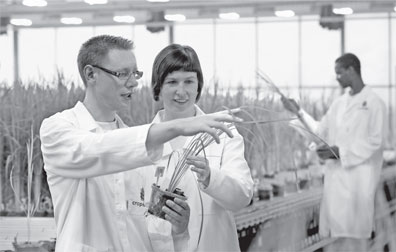|
New developments to ‘speed up’ evolution:
Exciting times for genetic research
By Pramod DE SILVA
 Charles Darwin caused a furore when he presented his Theory of
Evolution and Natural Selection. Now it is taken for granted. Evolution
is a process that has taken billions of years. Life on Earth has evolved
from the tiniest micro-organism to primates, including humans. Some
species, such as dinosaurs, have vanished in this relentless march of
time and evolution. Many other species on Earth too face the same
prospect due to various factors. Evolution is a process that continues
even as we write these lines. Life will find a way. Charles Darwin caused a furore when he presented his Theory of
Evolution and Natural Selection. Now it is taken for granted. Evolution
is a process that has taken billions of years. Life on Earth has evolved
from the tiniest micro-organism to primates, including humans. Some
species, such as dinosaurs, have vanished in this relentless march of
time and evolution. Many other species on Earth too face the same
prospect due to various factors. Evolution is a process that continues
even as we write these lines. Life will find a way.
But what if we can speed up evolution? For the first time in history,
Man now has the ability to change Nature’s will and designs through
genetic manipulation. The prospects for the future are both exciting and
frightening.
It was reported recently that humans could be “genetically
engineered” in as little as a decade, judging by the technological
advances currently being made in the field. This is indeed incredible,
considering that the human genome (the human gene sequence) was fully
deciphered only recently. Most biologists now agree that it is just a
matter of time before scientists develop the technology needed to
rewrite the DNA of living creatures, including humans. But is this not
tantamount to tampering with evolution?
Enter Multiplex Automated Genome Engineering or MAGE. The keyword
here is ‘Engineering’ which is already familiar to us through the term
‘Genetic Engineering’. But in this case, we are talking about a largely
automatic process which can essentially re-arrange genes. They already
have a word for it – The Evolution Machine.
 |
|
A genetically enhanced
mouse |
Gene tweaking used to be a laborious – and expensive process. It
would take years and millions of dollars just to manipulate a few genes
in even a lowly organism because life is very complex at any level, be
it a microbe or a primate. This picture could be changed with the advent
of new technology designed to speed up the process.
Revolutionary approach
The man credited with this revolutionary approach is George Church of
the Harvard Medical School, a founder of the Human Genome Project. His
system can add, change or switch off thousands of genes at a time and
generate billions of new strains in days. He has combined the scientific
concepts of parallel processing, automation and multiplexing in one
process for genetic manipulation. He hopes to sell the new machines at
around US$ 90,000 each, a far cry from the multimillion dollar genetic
rigs.
In an interview with New Scientist, he said the machine will greatly
accelerate the process of producing novel microbes. For example, LS9, a
biofuel company based near San Francisco hopes to use it to engineer E.
Coli that can produce renewable fuels. However, it should theoretically
work with any cell, plant, animal or microbe to rewrite the genomes.
This is an extremely expensive process at present – rewriting the genome
of even a bacterium can cost millions of dollars. Again, the new
advances can help bring down the cost.
But the biggest question is, can genetic engineering alter humans?
Will it be a good thing? Or could it be really dangerous? For years,
there has been a vigorous debate about the pros and cons of genetic
engineering, especially with regard to the more intelligent animals and
humans.
One of the most popular and controversial ideas is that the only
future aim of genetic engineering is cloning humans. On the downside,
critics of human genetic engineering have argued that human cloning
would be a rather dangerous idea with far-reaching consequences.
 |
|
A DNA strand |
Scientists have already cloned many other animals and the obvious
next step is a human experiment. On the other hand, no government is
likely to sanction such an effort due to moral and ethical
considerations. The very idea is abhorrent to most people. Human
cloning, at least in the form we envision it (a perfect copy of an
individual), may never really happen.
Genetic engineering
Cloning apart, there are many other ways in which we could actually
benefit from human genetic engineering. One of the most talked about
issues is whether genetic engineering can be used to prevent certain
congenital and other diseases or conditions such as blindness. This may
be controversial, but the benefits are readily apparent. There is also
the possibility that people suffering from spinal cord injuries could
get a new lease of life as a result of genetic engineering.
Human stem cells hold the key to all these possibilities. Stem cells
are cells that have still not specialised – it might become a retinal
cell, a lung cell or a blood cell. Scientists from the Genome Institute
of Singapore (GIS), an institute of the Agency for Science, Technology
and Research in collaboration with the Cancer Science Institute of
Singapore (CSI), have discovered how the body uses a single
communication system to decide the fate of stem cells.
But what if we could decide the potential use of a stem cell or alter
its genetic make-up to remove a fault that could develop into a
disability? That is the premise of stem cell research. It is promising
indeed.
It was revealed that the US National Human Genome Research Institute
aims to create human cell lines with different genomes to test ideas
about which mutations cause disease and how. If such mutations can be
prevented, the diseases could be stopped. They plan to use the MAGE
technique in this endeavour. This is a laudable initiative.
Everyday, there is encouraging news on the stem cell front. Just the
other day, I read about the successful use of stem cells derived from
human umbilical cord blood to deliver a novel therapeutic
gene—interleukin-12—to the brain for long-term anti-tumour activity
against gliomas, a deadly type of brain tumour.
Stem cells
 |
|
Plant genetic research |
Tests are now under way for MarrowStim PAD Kit, a treatment that
involves injecting a patient with his or her own stem cells in an
attempt to widen existing blood vessels or create new ones. With
developments like these, the stem cell(research) market was estimated to
be $21.5 billion globally in 2010 and is forecast to reach $63.8 billion
by 2015.
However, there is another aspect of genetic engineering that can be
boosted by evolution machines: Plant genetic research. There is a
controversy regarding Genetically Modified Food, but it could be the
only answer to the challenge of feeding a hungry world, which is equally
important as saving human lives lost to disease.
The human population will surpass nine billion by 2050, and 10
billion by the turn of the century. Scientists forecast that food
production must double or even triple to meet this demand. Agricultural
land is unlikely to expand. Genetic manipulation could lead to new
varieties of crops that are more disease resistant and better yielding.
It might even lead to the reduced use of chemical insecticides and
fertiliser in the long run.
The future is indeed exciting for genetic research. It is one of the
‘most happening’ sciences, with plenty of discoveries each week – plus
new controversies. The challenge is to use all these developments for
the betterment of humankind instead of using them for questionable
purposes. But we should tread with extreme caution where evolution and
nature are concerned.
|

